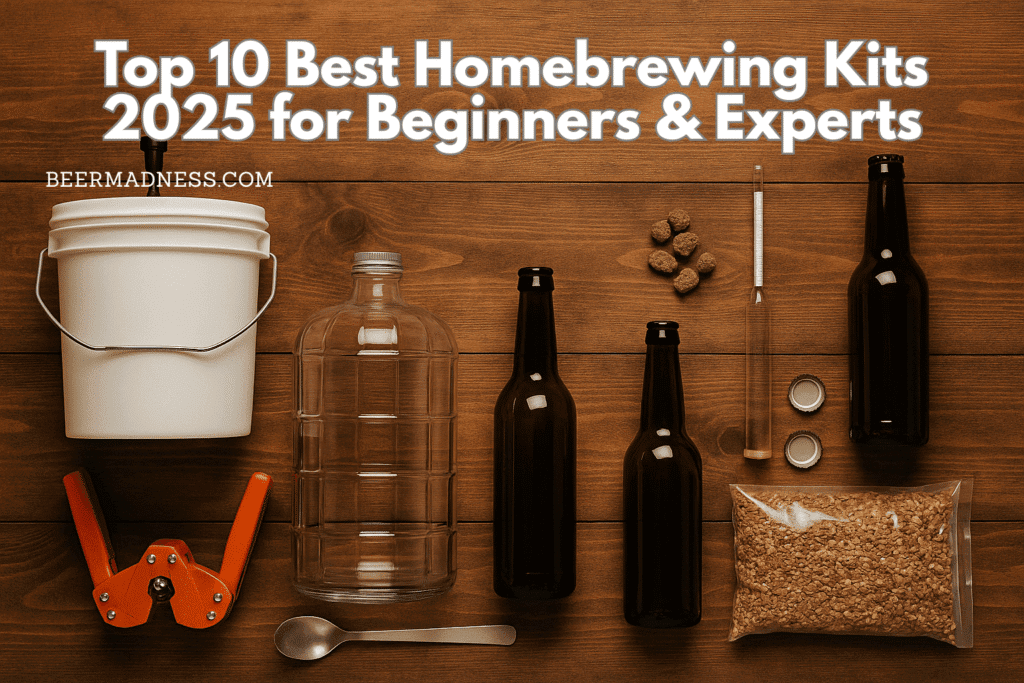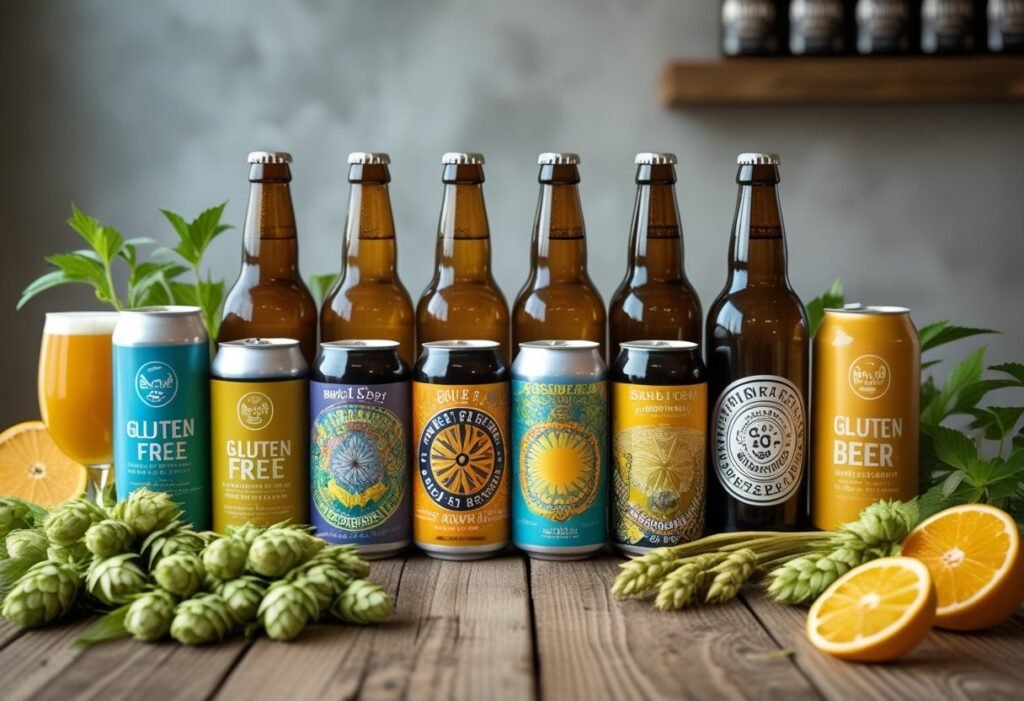Homebrewing has never been more exciting than in 2025. With the craft beer revolution continuing to thrive, more beer lovers are stepping into the world of brewing their own beer at home. Whether you’re looking to recreate your favorite IPA, experiment with seasonal stouts, or simply enjoy the satisfaction of crafting something unique, a homebrewing kit is the perfect place to start.
But not all brewing kits are created equal. Some are designed for complete beginners who want an easy entry point, while others are built for ambitious homebrewers ready to dive into advanced all-grain brewing. With so many options on the market, choosing the right kit can feel overwhelming.
That’s why we’ve created this comprehensive guide. In this article, you’ll discover the 10 best homebrewing kits of 2025, carefully reviewed for both beginners and experienced brewers. We’ll cover:
- The essential equipment included in each kit.
- Which kits are best suited for your skill level.
- Price ranges and value for money.
- Pros and cons of each option.
- Where you can buy them in 2025.
By the end, you’ll know exactly which brewing kit fits your needs, budget, and brewing ambitions—whether you’re making your very first batch or upgrading to a professional-grade system.
So, grab a pint of your favorite craft beer, and let’s dive into the world of homebrewing.
What Is a Homebrewing Kit?
A homebrewing kit is a complete package that provides the essential tools and ingredients to brew beer at home. Most starter kits include:
- A fermenter with an airlock.
- Sanitizer to keep equipment clean.
- Brewing thermometer and hydrometer.
- Ingredients such as malt extract, hops, and yeast.
- Step-by-step instructions.
There are different types of kits available:
- Extract Kits – Beginner-friendly, using malt extract instead of raw grain.
- All-Grain Kits – More advanced, offering full control over the brewing process.
- Complete Systems – Automated or semi-automated setups for experienced brewers.
Key Factors to Consider When Choosing a Homebrewing Kit
If you’re wondering “Which homebrewing kit should I buy?”, here are the five most important things to keep in mind:
- Skill Level – Pick a kit that matches your experience (beginner, intermediate, advanced).
- Batch Size – Decide whether you want small 1-gallon batches or larger 5-gallon brews.
- Beer Styles – Some kits are designed for specific styles like IPAs, lagers, or stouts.
- Budget – Starter kits can be under $100, while advanced systems can cost several hundred.
- Upgradability – Look for equipment that can grow with you as your skills improve.
👉 Quick Answer: The best homebrewing kit for beginners is one that balances ease of use, affordability, and clear instructions, while advanced brewers should prioritize all-grain systems and upgrade potential.
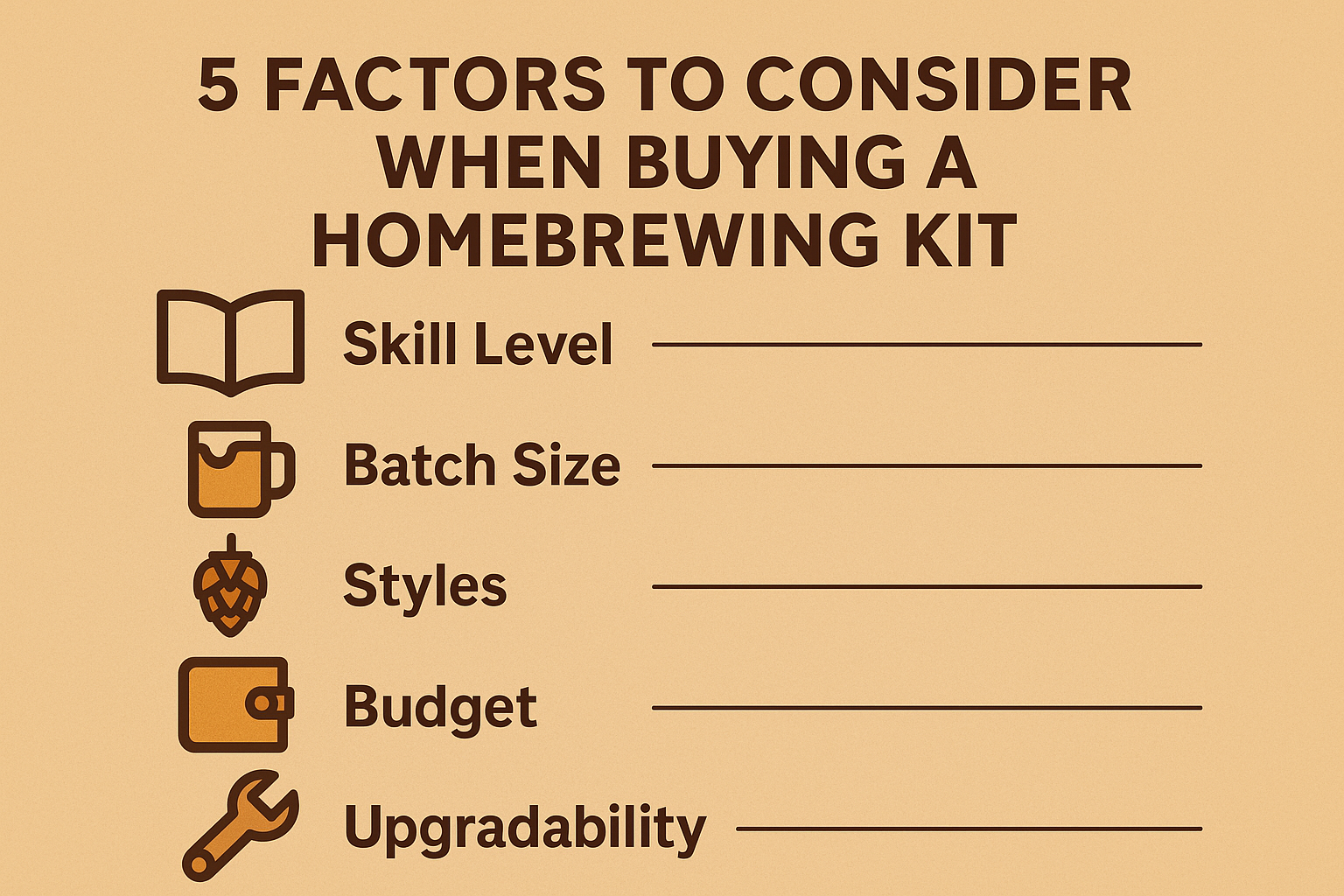
Top 10 Best Homebrewing Kits of 2025
This post may contain affiliate links. If you click and purchase, I may receive a small commission at no extra cost to you. Learn more
1. Northern Brewer Essential Starter Kit
The Northern Brewer Essential Starter Kit remains one of the best entry-level brewing kits in 2025. Designed specifically for beginners, it provides everything you need to brew your first batch without overwhelming complexity.
What’s included:
- Fermenter with spigot and airlock.
- Bottling bucket and tubing.
- Bottle capper and caps.
- Cleaning and sanitizing supplies.
- Ingredients for a classic beer recipe (usually an amber ale or pale ale).
Why it’s great for beginners:
Northern Brewer’s kit is known for its clear step-by-step instructions, quality equipment, and excellent customer support. Beginners will appreciate the simplicity, while still learning essential brewing techniques like fermentation and bottling.
Pros:
- Affordable price point for a full starter kit.
- Reliable, durable equipment that can be reused.
- Includes a recipe kit to get started immediately.
Cons:
- Plastic fermenter (less durable than stainless steel).
- Limited batch size options (usually 5 gallons).
👉 Best for: First-time homebrewers who want a straightforward introduction without cutting corners.
2. Brooklyn Brew Shop Everyday IPA Kit
The Brooklyn Brew Shop Everyday IPA Kit is perfect for apartment brewers or anyone short on space. Unlike larger 5-gallon setups, this kit brews 1-gallon batches, making it ideal for experimentation and casual brewing.
What’s included:
- 1-gallon glass fermenter.
- Airlock, tubing, and thermometer.
- Cleaning supplies.
- Ingredients for a fresh, hop-forward IPA.
Why it stands out in 2025:
The Brooklyn Brew Shop brand has carved a niche by making brewing stylish and accessible. Their kits often come in sleek packaging and focus on high-quality ingredients. The Everyday IPA remains their most popular choice, especially for hop lovers.
Pros:
- Compact and easy to store.
- Affordable entry point.
- High-quality ingredients with real grains and hops.
Cons:
- Smaller batch size (only 8–10 bottles).
- Limited scalability unless you buy additional equipment.
👉 Best for: Urban brewers, gift buyers, or beginners who want to try brewing without a big investment.
3. MoreBeer Deluxe Home Brewing Kit
The MoreBeer Deluxe Home Brewing Kit bridges the gap between beginner kits and advanced systems. It’s designed for those ready to take homebrewing more seriously, offering high-quality gear that can handle extract or transition to all-grain brewing.
What’s included:
- 6.5-gallon fermenter with spigot.
- Glass carboy for secondary fermentation.
- Racking cane, tubing, and bottling equipment.
- Hydrometer and thermometer.
- Recipe kit (choice of popular styles).
Why it’s a top pick:
The inclusion of a secondary fermenter (carboy) makes this kit more advanced than most starter sets. It teaches better fermentation practices and helps produce clearer, more professional-quality beer.
Pros:
- Higher quality equipment than basic kits.
- Secondary fermentation option for better beer clarity.
- Flexible: works with extract or all-grain recipes.
Cons:
- Larger setup requires more space.
- More complex for absolute beginners.
👉 Best for: Intermediate brewers ready to level up or beginners with ambitions to expand their brewing skills quickly.
4. Craft A Brew Starter Kit
The Craft A Brew Starter Kit is one of the most beginner-friendly brewing kits available in 2025. It’s affordable, approachable, and comes with everything you need to brew a 1-gallon batch of beer right at home.
What’s included:
- Glass carboy fermenter.
- Funnel, tubing, and airlock.
- Thermometer and sanitizer.
- Ingredients for your first beer (variety of styles available, including IPA, Hefeweizen, and Stout).
Why it’s a great choice:
Craft A Brew makes homebrewing unintimidating. Their instructions are extremely clear, and the smaller batch size makes it easier to control and experiment. Plus, they offer a wide range of recipe refills so you can keep brewing new styles without buying a whole new kit.
Pros:
- Affordable entry-level price.
- Excellent customer support and instructions.
- Wide variety of recipe options.
Cons:
- Only brews 1 gallon at a time.
- Equipment is basic compared to advanced kits.
👉 Best for: Beginners who want a simple, affordable way to start brewing.
5. Mr. Beer Premium Gold Edition Kit
If you’ve heard of homebrewing, you’ve probably heard of Mr. Beer. Their Premium Gold Edition Kit is one of the most well-known starter kits, offering a convenient and simplified approach to brewing beer.
What’s included:
- 2-gallon fermenter (keg-style).
- Pre-hopped malt extract cans.
- Yeast and carbonation drops.
- Bottles and caps.
Why it’s still popular in 2025:
Mr. Beer uses pre-hopped malt extract, which skips the boiling process and makes brewing nearly foolproof. While purists may prefer full-boil kits, this setup is excellent for those who just want drinkable homebrew quickly.
Pros:
- Extremely easy to use.
- Compact fermenter is perfect for small spaces.
- Wide availability online and in stores.
Cons:
- Beer quality can be basic compared to grain kits.
- Limited control over brewing process.
👉 Best for: Absolute beginners or casual brewers looking for simplicity and convenience.
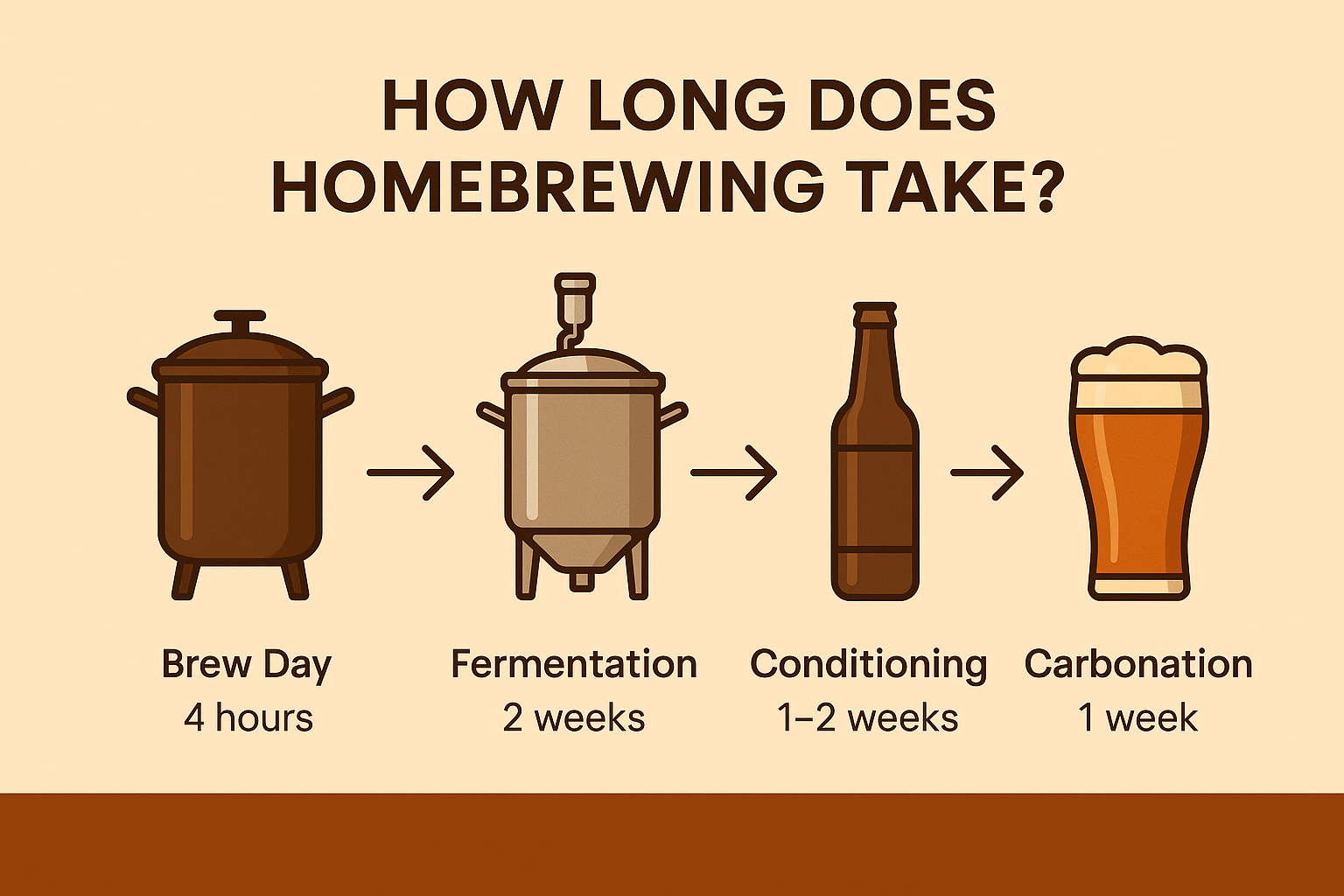
6. Brewer’s Best Deluxe Equipment Kit
The Brewer’s Best Deluxe Kit is a classic choice for serious beginners who want to start with reliable equipment that will last. This kit has been a favorite among homebrew clubs for years, and the 2025 edition continues to deliver.
What’s included:
- 6.5-gallon fermenter and bottling bucket.
- Glass carboy for secondary fermentation.
- Hydrometer, racking cane, tubing, and thermometer.
- Capper, caps, and cleaning supplies.
- Ingredient kit options.
Why it’s a solid investment:
The Brewer’s Best kit provides a complete foundation for homebrewing, making it easy to brew extract recipes while leaving room to transition into all-grain. Many brewers use this equipment for years before upgrading.
Pros:
- High-quality, durable gear.
- Suitable for both extract and all-grain brewing.
- Supports 5-gallon batches.
Cons:
- More complex than small-batch kits.
- Requires more space and storage.
👉 Best for: Beginners ready to commit or intermediate brewers wanting a solid upgrade.
7. Northern Brewer Brew. Share. Enjoy.® Starter Kit
Another excellent option from Northern Brewer, the Brew. Share. Enjoy.® Starter Kit is a slightly simplified version of their Essential Kit, designed to get beginners brewing with confidence right away.
What’s included:
- Fermenter with airlock.
- Bottling bucket and tubing.
- Bottle capper and caps.
- Recipe kit (typically a pale ale or IPA).
Why it’s beginner-approved:
This kit is perfect for gifting or for first-time brewers who don’t want to worry about extras. It offers a straightforward path to making 5-gallon batches, with equipment that can be reused and upgraded later.
Pros:
- Great introduction to full-size brewing.
- Affordable price point for a 5-gallon kit.
- Clear instructions and strong customer support.
Cons:
- Plastic fermenter isn’t as durable as glass or stainless steel.
- Lacks some advanced tools (like a hydrometer).
👉 Best for: New brewers who want a no-frills kit that just works.
8. Grainfather G30 (All-in-One Electric Brewing System)
The Grainfather G30 is one of the most advanced homebrewing systems on the market in 2025. It’s an all-in-one electric system designed for all-grain brewing with professional-level precision.
What’s included:
- Stainless steel brewing unit with digital controller.
- Integrated pump for recirculation.
- Counterflow wort chiller.
- Connectivity with Grainfather app for recipes and monitoring.
Why it’s a premium choice:
This system gives brewers complete control over mash temperatures, boil, and cooling, making it possible to brew beers nearly identical to professional craft breweries.
Pros:
- Professional-grade results at home.
- Fully integrated system reduces mess.
- Excellent community support and recipe database.
Cons:
- Expensive compared to starter kits.
- Learning curve for first-time brewers.
👉 Best for: Experienced brewers who want to brew high-quality all-grain beer with precision.
9. Anvil Foundry Brewing System
The Anvil Foundry is a direct competitor to the Grainfather, offering another top-tier all-in-one brewing system in 2025. Known for its durability and ease of use, it’s favored by brewers who want high-quality results without unnecessary complexity.
What’s included:
- Stainless steel kettle with electric heating.
- Built-in pump and recirculation.
- Adjustable grain basket.
- Digital temperature control.
Why it stands out:
Anvil is designed by the same company behind Blichmann Engineering, a highly respected name in brewing equipment. The Foundry combines reliability and performance in a slightly more affordable package than the Grainfather.
Pros:
- Excellent value for an advanced system.
- Durable stainless steel construction.
- Good balance of automation and control.
Cons:
- Bulkier than smaller kits.
- Still a higher investment for new brewers.
👉 Best for: Serious homebrewers who want an all-in-one system at a lower cost than top competitors.
10. PicoBrew (Pico Model C / Latest 2025 Update)
The PicoBrew Pico system is one of the most innovative homebrewing solutions, combining convenience with smart technology. Updated for 2025, the Pico line offers an automated brewing experience unlike traditional kits.
What’s included:
- Compact brewing machine.
- Pre-packaged PicoPaks (grains, hops, yeast).
- Automated fermentation and temperature control.
- Wi-Fi connectivity for recipes and updates.
Why it’s revolutionary:
The Pico system essentially turns brewing into a push-button process. While traditionalists may find it too “hands-off,” it’s perfect for those who want fresh beer with minimal effort.
Pros:
- Extremely easy to use.
- Compact, stylish design.
- Access to a large library of beer recipes.
Cons:
- Limited customization compared to manual brewing.
- Ongoing cost of PicoPaks.
👉 Best for: Casual brewers who value convenience and consistency over full control.
Comparison Table: Best Homebrewing Kits of 2025
| Kit | Batch Size | Type | Best For | Price Range | Key Features |
|---|---|---|---|---|---|
| Northern Brewer Essential Starter Kit | 5 gallons | Extract | Absolute beginners | $$ | Complete starter kit with recipe, reusable equipment |
| Brooklyn Brew Shop Everyday IPA Kit | 1 gallon | All-grain (mini) | Urban brewers, gifts | $ | Compact, stylish, IPA-focused kit |
| MoreBeer Deluxe Home Brewing Kit | 5 gallons | Extract / All-grain transition | Ambitious beginners & intermediates | $$$ | Includes glass carboy for secondary fermentation |
| Craft A Brew Starter Kit | 1 gallon | Extract | First-timers on a budget | $ | Affordable, lots of recipe refills available |
| Mr. Beer Premium Gold Edition Kit | 2 gallons | Extract (pre-hopped) | Casual brewers, no-fuss beginners | $ | Pre-hopped extracts, keg-style fermenter |
| Brewer’s Best Deluxe Equipment Kit | 5 gallons | Extract / All-grain capable | Beginners ready to commit | $$$ | Durable, complete foundation kit with glass carboy |
| Northern Brewer Brew. Share. Enjoy.® Kit | 5 gallons | Extract | Gifting or straightforward brewing | $$ | Simple, effective kit with recipe |
| Grainfather G30 System | 5–6 gallons | All-in-one electric | Advanced brewers | $$$$ | Digital controls, app connectivity, counterflow chiller |
| Anvil Foundry System | 5–6.5 gallons | All-in-one electric | Serious hobbyists | $$$ | Durable stainless steel, adjustable grain basket |
| PicoBrew (Pico C / 2025) | 1.3 gallons | Automated | Convenience-focused brewers | $$$ | Push-button brewing with PicoPaks |
Tips for Success With Your First Homebrew
Even with the best homebrewing kit, success depends on how you handle the process. Here are some proven tips to make sure your first batch is a winner:
1. Sanitation Is Everything
The single most important rule in homebrewing: keep it clean. Any stray bacteria or wild yeast can ruin your beer. Use the sanitizer provided in your kit (or a product like Star San) on all equipment before and after use.
2. Follow Instructions Closely the First Time
Every kit comes with a detailed brewing guide. For your very first batch, stick to the instructions exactly. Once you’ve brewed successfully, you can start experimenting with hops, grains, and timing.
3. Control Fermentation Temperature
Yeast is sensitive to temperature. Too hot, and you’ll get off-flavors. Too cold, and fermentation may stall. Keep your fermenter in a stable environment, ideally between 18–22°C (65–72°F) unless your kit specifies otherwise.
4. Take Notes and Learn From Each Batch
Keep a simple brewing journal. Record your starting gravity, fermentation time, and tasting notes. This helps you track progress and improve with each brew.
5. Don’t Rush the Process
Patience pays off in brewing. Give your beer enough time to ferment, condition, and carbonate. Cutting corners almost always results in flat or unbalanced beer.
6. Start With Easy Styles
For your first brew, stick to forgiving beer styles such as amber ales, pale ales, or wheat beers. These styles hide small mistakes better than lagers or delicate IPAs.
7. Share With Friends and Get Feedback
One of the best parts of homebrewing is sharing the results. Invite honest opinions—just remember that even professional brewers had batches that didn’t go as planned in the beginning.
The best tips for a successful first homebrew are: sanitize everything, follow instructions, keep fermentation temperatures steady, take notes, and be patient.
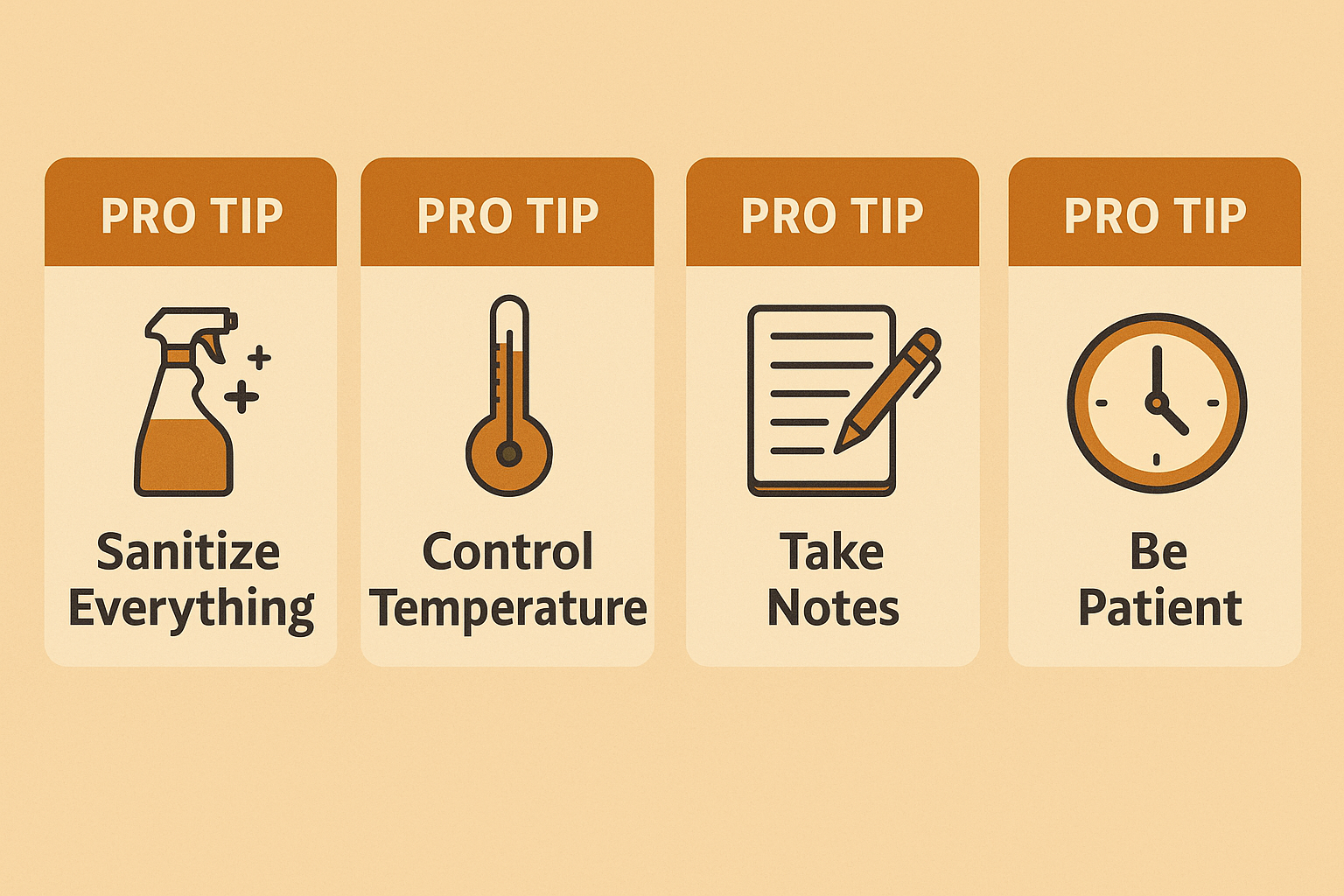
Where to Buy Homebrewing Kits in 2025
Once you’ve decided which kit suits your needs, the next question is: where should you buy it? In 2025, homebrewing kits are more accessible than ever, with multiple trusted retailers offering different advantages.
1. Direct From Manufacturers
Buying directly from brands like Northern Brewer or MoreBeer ensures you get the latest kit versions, fresh ingredients, and customer support. This is often the best choice if you want to buy add-ons, recipe refills, or upgraded equipment later.
2. Specialty Online Shops
Retailers such as Beers of Europe cater specifically to beer lovers. Not only do they stock popular homebrewing kits, but they also offer a wide range of ingredients, glassware, and craft beers. This makes it easy to bundle your kit with some extras.
3. Amazon
For sheer convenience, Amazon UK and Amazon US remain the most popular options. Amazon often offers fast shipping, customer reviews, and competitive prices, making it easy to compare different kits side by side. Many of the kits in this list are available there.
4. Local Homebrew Shops
Don’t overlook your local homebrew store. Visiting in person allows you to:
- Get personalized advice from experienced brewers.
- See the equipment before buying.
- Support local businesses and brewing communities.
5. Beer Travel Tie-ins
If you’re interested in turning your new hobby into a passion-filled trip, consider combining it with experiences like Viator’s brewery tours or even beer-themed accommodation via Hotels.com. It’s a great way to learn more about brewing while enjoying craft beer culture around the world.
What is the best homebrewing kit for beginners?
For beginners, the Northern Brewer Essential Starter Kit or the Mr. Beer Premium Gold Edition are the most user-friendly options in 2025. They include clear instructions, small learning curves, and all the essentials to get started quickly.
How much does a homebrewing kit cost in 2025?
Prices vary depending on the size and complexity of the kit:
– Small-batch starter kits (1 gallon): $40–$70
– Full-size beginner kits (5 gallons): $100–$200
– Advanced all-in-one systems: $400–$900+
How long does it take to brew beer at home?
Most homebrews take 4–6 weeks from brewing day to drinking. Brewing itself only takes 2–4 hours, but fermentation, conditioning, and carbonation require patience.
Do I need extra equipment beyond the kit?
Most starter kits come with the basics, but you may need:
– A large stock pot (if not included).
– Bottles or kegs for packaging.
– Extra sanitizer.
Can I make different beer styles with one kit?
Yes. Once you have the equipment, you can brew a wide variety of styles by purchasing refill recipe kits (grains, hops, yeast). Some kits are style-specific (e.g., IPA kits), while others are versatile.
Is homebrewing cheaper than buying beer?
In the long run, yes. A 5-gallon batch makes about 48 bottles of beer, often at a cost of $0.75–$1.25 per bottle. However, the initial investment in equipment makes the first few batches more about the experience than savings.
What’s the easiest beer style to brew for beginners?
Amber ales, pale ales, and wheat beers are the most forgiving. They mask small mistakes and don’t require precise temperature control like lagers do.
Conclusion: Start Your Brewing Journey in 2025
Homebrewing is one of the most rewarding hobbies you can take up in 2025. Whether you’re aiming for a crisp IPA, a malty stout, or just want to understand the craft behind your favorite beers, the right kit makes all the difference.
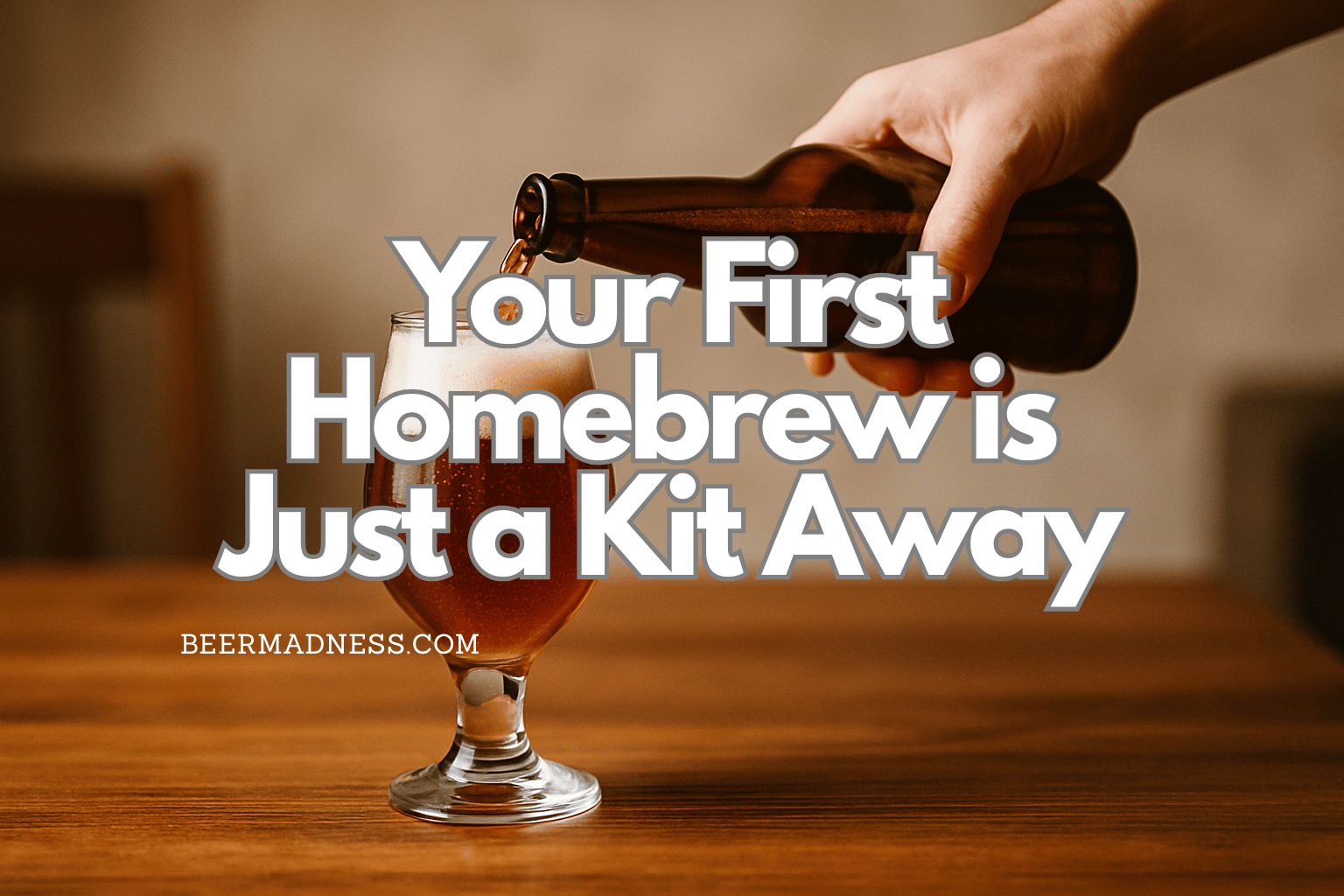
From simple one-gallon starter kits like Craft A Brew and Brooklyn Brew Shop, to advanced systems like the Grainfather G30 and Anvil Foundry, there’s a perfect option for every skill level and budget.
Beginners should prioritize simplicity, clear instructions, and affordability. Intermediate brewers may want kits with secondary fermentation and upgrade potential. Advanced homebrewers can invest in all-in-one systems for professional-level control.
👉 No matter which path you choose, the key is to start brewing and learn by doing. Every batch teaches you something new, and before long, you’ll be crafting beers that rival your favorite craft breweries.
Ready to Brew?
- ✅ Explore Beers of Europe for curated kits and ingredients.
- ✅ Compare Amazon UK for deals and fast shipping.
- ✅ Check Northern Brewer for complete starter bundles.
If you found this guide helpful, make sure to check out our other articles on BeerMadness — from the Top IPA Beers in the UK 2025 to BBQ & Beer Pairing Tips.
🍻 Your first homebrew is just a kit away — so grab one, get brewing, and enjoy the satisfaction of crafting your very own beer at home.

